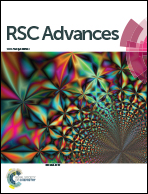Nanoclay stabilized Pickering miniemulsion of fluorinated copolymer with improved hydrophobicity via RAFT polymerization†
Abstract
This investigation reports the preparation of fluorinated copolymer/clay nanocomposite latex by Pickering miniemulsion polymerization using nanoclay sodium montmorillonite (NaMMT) as sole stabilizer. In this case the copolymerization of styrene (St), butyl acrylate (BA) and 2,2,3,3,4,4,4-heptafluorobutyl acrylate (HFBA) was carried out via Reversible Addition–Fragmentation chain Transfer (RAFT) process. Addition of 2-(acryloyloxy) ethyl trimethylammonium chloride (AETAC) increased the rate of polymerization. As nanoclays are negatively charged silicate layers, AETAC, a cationic monomer was introduced to increase the polymer–clay interaction via ion-exchange which has beneficial effect on the final properties of the copolymer. The copolymers had controlled molecular weights as well as narrow dispersity (Ð). Nanoclay armored morphology was observed by TEM and SEM analyses. The polymers had improved hydrophobicity and lower water uptake rate due to improved polymer–clay interaction.


 Please wait while we load your content...
Please wait while we load your content...